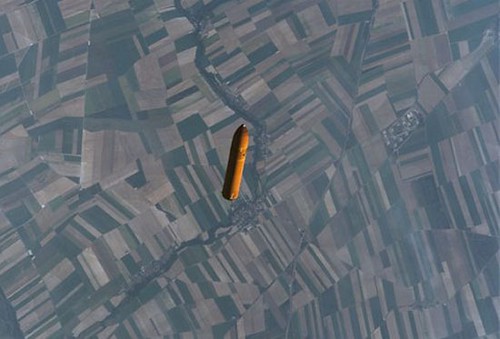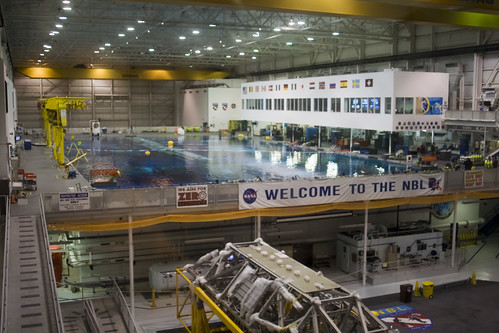Tag: spaceflight
T-11 hours Hold
Right now NASA is in the middle of the T-11 hours hold (more info on shuttle countdowns), a built-in hold of 13 hours 22 minutes, with the following main tasks to be accomplished:
- Weather and engineering briefings
- Pad debris inspection and closeout
- Flight crew equipment late stow
- Move rotating service structure to “park” position
- Activate the orbiter’s inertial measurement units and communications systems
- Perform ascent switch list
Sometime today, the official launch time was shifted one second, but the planned launch is still 3:47 p.m. EDT Friday which is in the middle of the ten minute launch window. During the planned T-9 minute hold, the shuttle managers will make adjustments to the launch time as required.
If you want the current mission minutiae, watch STS-134 – Countdown Status Briefing April 28.
The countdown will resume at T-11 hours (11:22 p.m. EST).
The weather forecast calls for a 70 percent chance of favorable conditions at launch time – so pray for mojo.
As a personal matter, I’m in Orlando now, in the suburban oasis which is the airport Holiday Inn.
STS-134 Crew Arrival
On the Space Shuttle External Tank

The very large, very orange, object on the Space Shuttle stack is the External Tank (ET) which holds fuel in the form of iquid hydrogen (LH2) fuel and liquid oxygen (LO2) oxidizer which mix in the three Space Shuttle Main Engines (SSME). The ET is the only non-reusable lift object: the ET is jettisoned just over 10 seconds after Main Engine Cut Off (MECO).

Above: the External Tank. The right hand pipe is the LO2 feedline which enters the shuttle near the orbiter LH2 feedline and umbilicals at the aft attachment point.
The ET is covered in foam in order to keep the fuel liquid – this is the same foam which cause the catastrophic loss of the Space Shuttle Columbia when during liftoff a suitcase-size piece of thermal insulation foam broke off from the ET, striking Columbia’s left wing panels. The specific piece of foam which broke off (the Left Bipod Foam Ramp) was designed to reduce aerodynamic stresses around the bipod attachment to the shuttle, and on further missions this piece was removed from design and flight.

There are three main parts to the ET: the iquid hydrogen (LH2) fuel tank (bottom), liquid oxygen (LO2) oxidizer tank (top) and the intertank connecting the two pieces. The large exterior line is the LO2 feedline which is 17″ in diameter which is connected to the space shuttle at the bottom mating points.
The specific ET which is being flown on STS-134 is ET-122 which was refurbished after damage during Hurricane Katrina, being fully certified and flight-worthy. As a NASA manager stated, It might not be pretty, but it is fully flight ready.
To mark the return of ET-122 to flight-worthy status, Lockheed Martin created a Return to Flight logo which was applied to the Intertank Access Door at the request of NASA, the first of its kind. The logo is below (courtesy of Lockheed Martin):

Below are photos of the ET, LO2 Feedline, and space shuttle mating section:
ET-122 Rollout to Barge (NASA, 9/20/10) by NASA’s Marshall Space Flight Center:
External tank-shuttle bipod:
17″ O2 Feedline at Top of the External Tank:
LH2 Feedline (O2 Feedline behind) at orbiter aft attachment point:
- Space Shuttle External Tank
- Orbiter propulsion datasheet from NASA
- Solid Rocket Boosters
- Shuttle main engines
- mobile launcher platform
This is another in a series of posts documenting my time around the liftoff of STS-134 Space Shuttle Endeavour. For more posts, check out my STS-134 Launch Page.

Endeavour Silhouette
STS-134 Launch

Next week I will be heading down to Florida to (hopefully) watch the launch of STS-134 Space Shuttle Endeavour. STS-134 is the penultimate voyage of the Space Shuttle utilizing Endeavour, deilvering payload to Space Station consisting of the Alpha Magnetic Spectrometer (AMS-2) and ExPRESS Logistics Carrier (ELC-3), performing four spacewalks (EVA) and performing various experiments, including STORRM DTO and GLACIER Freezer Module.
Just like when I went to the Johnson Space Center STS-130 Tweetup to meet astronauts and cool NASA people, I’ll be posting photos, interviews and commentary. Follow my updates right here on Smogr, or on my STS-134 Launch Page, which will aggregate my Twitter updates, and Flickr photos.

Mission Control Screen – A Primer
 Blue FCR Screen, originally uploaded by plemeljr
Blue FCR Screen, originally uploaded by plemeljr
If you watch NASA TV the producers often put up a map (example above) showing the location and orbits of Station and Shuttle, with all sorts of additional lines overlaid on the map. Here’s an abridged list of what they are and mean:
- Yellow & Green Lines
This represents the TDRS (pronounces Tee-dris) which is a series of nine geosynchronous satellites which handle space-to-ground communication. If Station or Shuttle is inside either the circle, they have to switch over from one system to the other (LOS or AOS). If Station and Shuttle are in the overlapped area (as is shown) then they temporarily lose strong communication to the ground - White brackets at orbit line
This represents the sunrise/sunset time and location for Station or Shuttle. - Blue circles with acronyms
This represents comms unavailability for various backup communication systems, mostly military. - White polygon in South America with the acroynym
SAA
This stands for the South Atlantic Anomaly. This refers to the area where the Earth’s inner Van Allen radiation belt comes closest to the Earth’s surface leading to an increased flux of energetic particles in this region, exposing orbiting satellites to higher than usual levels of radiation. This location has to do with the off-axis rotation of Earth and the translation of the radiation belt. Station and Shuttle periodically go through this ever-changing anomaly during orbit, affecting communication, but also placing astronauts at higher risk of radiation requiring additional precautions.
A diagram of the SAA is below:


This article continues my reporting of my junket NASAtweetup at the Johnson Space Center on 17 FEB 2010. For all articles, check out the NASA tweetup page and photos.
Neutral Buoyancy Laboratory
 NBL Overview, originally uploaded by plemeljr
NBL Overview, originally uploaded by plemeljr
In order for astronauts to simulate and acclimate zero gravity, NASA uses the massive Neutral Buoyancy Laboratory (NBL), which is in effect a very long, deep, and largest swimming pool in the world. The NBL is not on the Johnson Space Center (JSC) main campus, but is a 10 minute drive, being housed in a converted warehouse. Here, full-sized high-fidelity Station mockups sit in 40 feet of water in order for astronauts and support staff to train for upcoming missions. Generally, two astronauts are on EVA at any one time (the buddy system), and each work together to perform a series of tasks according to the upcoming mission goals. For every astronaut who enters the water there are four additional NBL divers to assist the astronaut: one diver controls a video camera which records the training runs for both mission planners and the astronaut subjects, one tools diver who assists the astronaut, and finally two safety divers. The amount of equipment and weight of the suits make it all but impossible for the astronaut subjects to enter or exit the water without a great deal of assistance.

This training not only develops muscle memory and familiarity with Station, but also allows astronauts and support staff to develop and perfect orders of operations. Our dive escort noted that generally an overall outline and EVA mission goals have been agreed to prior to training at the NBL, but depending on the mission type and complexity, methods and procedures are worked out inside the NBL. Astronauts shoot for seven hours of training at the NBL for every one hour in EVA, though generally this fluctuates between five to eight. Generally they enter the water at 9 am and exit around 3 pm – a full day of work.

This article continues my reporting of my junket NASAtweetup at the Johnson Space Center on 17 FEB 2010. For all articles, check out the NASA tweetup page and photos.
Near the End for Reusable Manned Spaceflight

Space Shuttle Endeavour’s current mission, STS-130 (wikipedia), delivered and assisted in assembling the final International Space Station module, Tranquility Node 3/Cupola. There are only four additional Space Shuttle flights until the fleet of remaining orbiters – Endeavour, Discovery and Atlantis – will be permanently retired. Thus ending the era of reusable manned space flight.
Station will continue to be serviced from Russia through the use of Soyuz and Progress, and by the Euopean Automated Transfer Vehicle. These are single-use rockets and remote controlled supply platforms, which will ferry both humans and material to Station.
President Obama recently unveiled his FY2011 budget outlining, with little surprise, the reduction of funding for any manned mission to Luna or Mars:
US space agency Nasa has already spent $9bn (£5.6bn) on the programme.
The president said Constellation was draining resources from other US space agency activities. He plans instead to turn to the private sector for launch services.
“While we’re cancelling Constellation, we’re not cancelling our ambitions,” said Jim Kohlenberger, chief of staff at the White House Office of Science and Technology Policy (OSTP).
“This isn’t a step backwards. I think the step backwards was trying to recreate the Moon landings of 40 years ago using largely yesterday’s technology, instead of game-changing new technology that can take us further, faster and more affordably into space.”
The decision to cancel Constellation was immediately condemned by Congressional figures who represent workforces dependent on the programme.
This is unsurprising, due to the fact that the Bush Administration’s lofty goal of manned missions to Luna and Mars lacked an essential item: any real funding whatsoever. Any future manned flights will come from private or public-private joint ventures.
The era of the Moonshot is over.
While the budget is pragmatic – especially in the current political environment – this is unfortunate. Humans are still stranded on a single blue planet, which we continue to neglect. Global Warming and climate change is real, and the probability of major climate events negatively affecting the population is growing. Colonizing other planets, while wonders of science fiction, increases our survival chances. Until there is a major trigger (Chinese settle Luna?), I don’t see manned space flight being anywhere near a priority of the USA in the near future.
This is also unfortunate since once we disband Project Constellation and Orion platforms, the professionals developing those programs will be scattered to the wind. With funding also goes facilities, such as the Space Vehicle Mockup Facility where NASA continues to develop the Orion module today.
When I was at NASA’s Johnson Space Center, it was mentioned more than once that Constellation and Orion was to defunded during FY2011, but there was never any plea for us to apply pressure to our Congresspeople. Rather it was plain that they were professionals, yet disappointed that these programs could end. One NASA engineer commented that they hope it is decided one way or another to fund or defund so they could plan out the rest of the fiscal year: either to push ahead with continued mockups, testing and design or reach an agreed upon fidelity, then wrap up the program in a way which the learnings and technology could be handed off to a third party.
If you have an opinion, please contact your Member of Congress.

This article continues my reporting of my junket NASAtweetup at the Johnson Space Center on 17 FEB 2010. For all articles, check out the NASA tweetup page and photos.
Space Shuttle main engines
 Space Shuttle main engines, originally uploaded by plemeljr
Space Shuttle main engines, originally uploaded by plemeljr

This article continues my reporting of my junket NASAtweetup at the Johnson Space Center on 17 FEB 2010. For all articles, check out the NASA tweetup page and photos.






